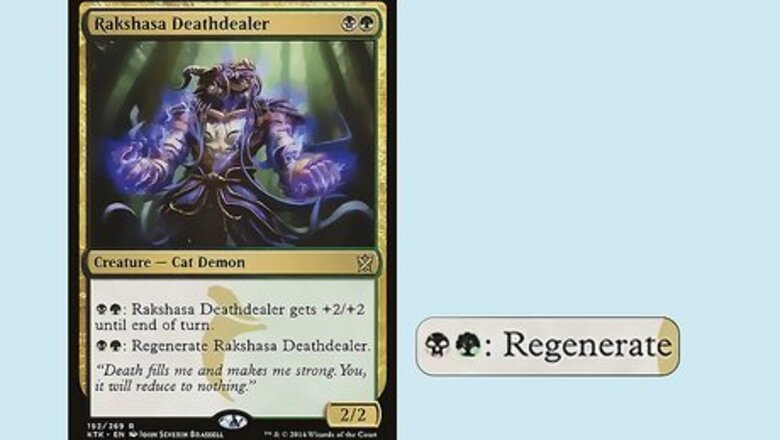
views
- Regenerate is an activated ability and a replacement effect.
- A creature with regenerate basically gets a shield from one instance of death, but only from “destroy” effects or combat damage.
- Regenerate removes a creature from combat, so an attacker that regenerates won’t deal damage, and a blocker that regenerates won’t be assigned damage.
Regenerate and Regeneration Rules

Regenerate is an ability that can prevent a creature from dying. Regenerate is a replacement effect, which means that when it is activated, it literally replaces another effect from occurring. For regenerate, that effect is the death of a creature in two scenarios: when the creature is the target of effects that say “destroy” or when the creature is about to be dealt lethal combat damage. Here are the essential rules surrounding regenerate: Regenerate must be activated before combat damage occurs or before effects that say “destroy” resolve. To regenerate a card, pay the regenerate cost, tap the creature, and remove it from combat. You can still regenerate a creature if it’s already tapped or removed from combat. Regenerate only prevents one instance of lethal damage or destruction. However, you can activate multiple instances of regenerate so long as you can afford the costs. Think about regenerate kind of like a bubble that covers the creature. Once that bubble is popped, the creature can be killed again.
Scenarios Where Regenerate Doesn’t Work

The creature’s toughness is set to zero. Cards that do not destroy or deal combat damage but kill creatures by lowering their toughness get around regenerate because of state-based effects. In Magic, state-based effects refer to anything that is just true about the game at a given time. One of those effects are “creatures must have a toughness higher than zero or else they go to the graveyard.” So, as an example, Drown in Sorrow will kill a Rakasha Deathdealer even if you regenerate it. However, the Deathdealer would live if you used its other ability to give it +2/+2 to make it a 4/4 for the turn!

The creature is bounced, blinked, or exiled. Cards like Vapor Snag, Path to Exile, and Journey to Nowhere don’t care about regenerate. If a card says “return target permanent” or “exile target permanent,” regenerate isn’t going to prevent the card’s effect from resolving. Regenerate only cares about combat damage and the word “destroy.”
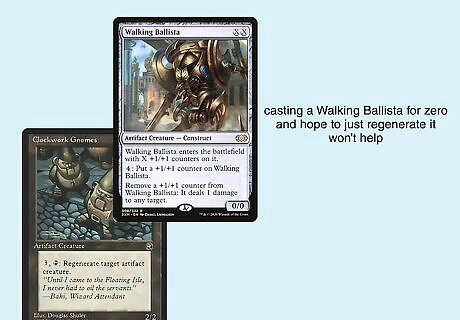
The creature is already in the graveyard. If the creature has already gone to the graveyard for whatever reason, the regenerate ability won’t do anything. This can seem kind of odd if the creature dies for a state-based reason. For example, if you cast a Walking Ballista for zero and hope to just regenerate it using something like Clockwork Gnomes, the Ballista will just die immediately.
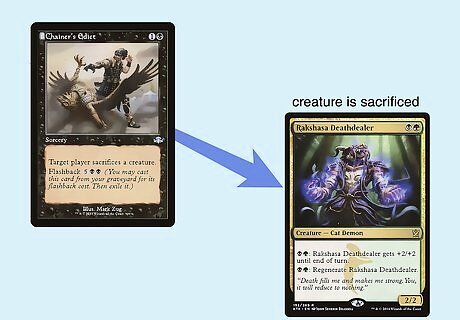
The creature is sacrificed. If you have nothing but a Rakasha Deathdealer on your side of the board and your opponent casts a card like Chainer’s Edict that forces you to sacrifice a creature, regenerating the Deathdealer won’t do anything.

The creature is targeted by a card that says it can’t be regenerated. Take a look at Terror. The card text explicitly states that the creature it is targeting to destroy “can’t be regenerated.” This “can’t” clause cannot be ignored, so any card that explicitly states regeneration doesn’t do anything trumps regenerate effect.
Other Rules

Tapping/untapping A creature with a resolved regenerate ability is tapped once it is dealt lethal damage or destroyed. A creature can still be regenerated a second time after it has been tapped. You can attack with a regenerated creature, but only if you untap it somehow before the declare attackers step.

Deathouch & regenerate Deathtouch removes regenerate the way you’re likely imagining. There’s nothing unique about the interaction here. A single point of deathtouch damage will remove a regeneration shield. Once the regeneration bubble is popped, the creature that had the regeneration effect on it is no longer protected. Note that deathtouch does not remove the shield if the creature’s regeneration ability is activated mid-combat.
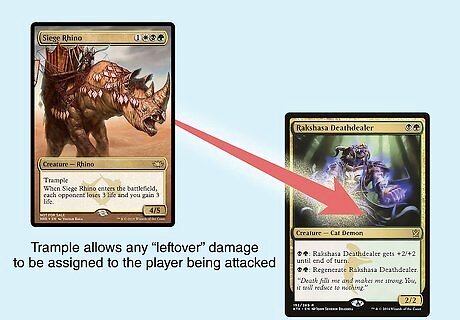
Trample & regenerate Any trample damage that would spill over does so. Trample allows any “leftover” damage to be assigned to the player being attacked. So, let’s go back to the Deathdealer and Siege Rhino. Rakshasa Deathdealer is a 2/2 and Siege Rhino is a 4/5 with trample. Even if the Deathdealer blocks and regenerates, the Rhino will deal 2 damage the other player. Note that if the creature with regeneration is removed from combat by a regeneration ability, all 4 of the Siege Rhino’s damage would go through to the player!
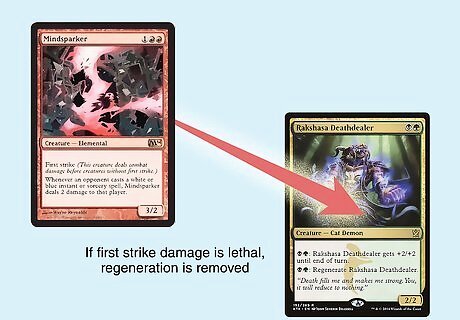
First strike, double strike, & regenerate If first strike damage is lethal, regeneration is removed. So long as the creature with first strike is doing enough damage to kill the regenerated creature, it will remove the regenerated shield. Notably, regeneration removes a creature from combat, so double strike, which grants both first strike and normal combat damage, doesn’t interact with regenerate. Regenerate removes a creature from combat, so once the first strike damage resolves there’s nothing to hit.
An Example of How Regenerate Works
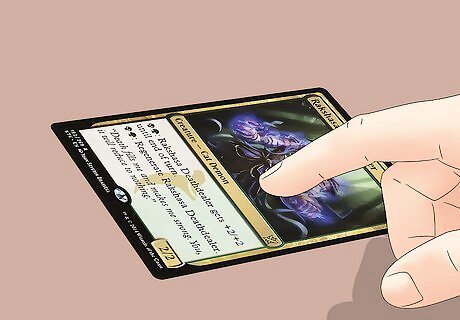
You attack with a Rakshasa Deathdealer. Let’s say you’ve got a Rakshasa Deathdealer on your board. It doesn’t have summoning sickness, and you decide to attack with it. You declare attackers and turn Rakshasa Deathdealer sideways to tap it. Rakshasa Deathdealer’s regenerate ability costs one black and one green mana. If its regenerate ability required tapping itself, like a Crypt Sliver on an empty board, you wouldn’t be able to activate it after attacking.

Your opponent blocks with a larger creature. Let’s say your opponent has a Siege Rhino on board and they decide to block the Rakshasa Deathdealer with it. They put the 4/5 Rhino in front of your 2/2 Deathdealer and say, “Move to damage?” to signal that they’re done blocking and ready for damage assignment.

You activate the Deathdealer’s regenerate ability. Siege Rhino is a 4/5, so normally, it would kill the 2/2 Rakshasa Deathdealer. So, you tap one forest and one swamp to pay the mana needed to activate the regenerate ability. You announce, “I’ll regenerate” and you move to damage. Remember, activated abilities can be activated at instant speed, so you can activate the Deathdealer’s regenerate ability whenever you’d cast an instant. Your opponent has an ability to respond to your regeneration trigger! If they cast Fatal Push before the regeneration ability resolves and you’re out of mana, the Deathdealer will die.

The regenerate effect removes the Deathdealer from combat. This is where people get mixed up. Regenerate removes the creature in question from combat. So, in this instance, the Deathdealer is taken out of combat and no damage takes place. The regenerate “shield” is still on the creature! If the Rhino were the one attacking and the Deathdealer were blocking, the Rhino would still be considered blocked even though the Deathdealer was removed from combat.
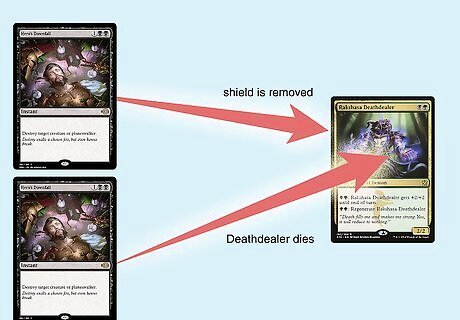
Your opponent casts two removal spells to kill the Deathdealer. Okay, so now let’s say your opponent is really annoyed and just wants to get rid of the Rakshasa Deathdealer more than anything in the world. They cast two copies of Hero’s Downfall. Here’s what happens: The regenerate ability is still protecting the Deathdealer, so the first Hero’s Downfall resolves and the Deathdealer survives. It remains tapped and the “shield” is removed. The second Hero’s Downfall resolves and the Deathdealer dies the same way it normally would. Note that if you had another forest and swamp available, you could regenerate it in response to the second Hero’s Downfall to protect it again.




















Comments
0 comment